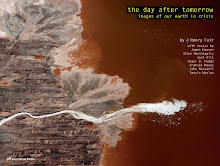...otherwise, how would we get all that oil that we know lies under the Arctic? It’s a bit of a nuisance that the northeast has to suffer from such a rotten winter for it, but believe me, and ice-free North Pole will be better for everyone. Of course, we might have to fight the Russians for the mineral rights, but we’ll kick some commie butt just like we did the last time.
Our hunger for petrol and dwindling supplies are driving exploration farther afield, and the Arctic is the next on the list for extraction.
The recent spill in the Gulf Of Mexico taught the world much about oil spills and response. Fortunately, the spill happened in the spring within 200 miles of some of the most well-equipped ports in the world for offshore oil operations. In the Beaufort Sea, where Shell is preparing to drill north of Alaska, there is not a deepwater port for a thousand miles, and that one is a one-horse harbor in the middle of the ocean. The water in the area is only navigable a portion of the year, and periodic storms with “sustained winds may reach 65 to 70 knots; significant wave heights can climb to 40 to 50 feet” occur every few years.
A recent European study on Arctic weather forecasts "large increases in the potential for extreme weather events" and warns that "commercial activities in the North (e.g. fisheries, oil industry, shipping) will become increasingly vulnerable" to severe Polar low-pressure systems, described as the "Arctic Cousins" of tropical hurricanes.
Of course, as the weather gets rougher, accidents will increase and remediation becomes more difficult.
Until recent years, technology limitations and low oil prices have kept this vast repository of hydrocarbon wealth essentially out of reach of extraction. Those limiting factors are rapidly diminishing and oil companies are rushing to get a stake in the action. Logically, disasters, delays, and cost overruns would be directly proportional to severity of site conditions and distance from logistical support.
Some recent developments in Arctic petroleum exploration/extraction:
-The Norwegian national oil company Statoil has been producing gas from its Snøhvit drilling site above the Arctic Circle since September 2007. The ambitious project is completely sub-aqueous, and has been plagued with delays, overruns, and un-permitted greenhouse gas releases since the beginning. Statoil is one of the biggest players in some of the dirtiest hydrocarbon projects in the world, including the Catskills hydro-fracking controversy.
-BP has recently signed a deal with the Russian state-owned Rosneft to explore the Arctic areas off Russia’s continental shelf. Neither Russia or BP are known for their attention to the environment or safety record.
-Shell has received permits to begin exploration off the north coast of Alaska in the Beaufort Sea, and is moving equipment, including a drill ship and a newly built spill response ship into the area in anticipation. When one remembers that thousands of vessels were involved in the BP Deepwater cleanup, and one specialty disaster response ship seems inadequate. Shell has a record of environmental destruction and governmental manipulations in their projects around the world.
-Cairn Energy began drilling off the Arctic Coast of Greenland this summer, but had to stop after GreenPeace activists suspended themselves from structure of the drill rig.
If you were hoping that peak oil would arrive and provide the restraint that we seem to lack as a species, vis-a-vis our carbon addiction, think again. The dirty oil sources (like the tar sands) will allow us to continue to push up the atmospheric CO2 meter at an increasingly accelerated pace. Of course, when all of the ice has melted, the oceans will only rise 220 feet, so if you are in the mountains you’ll be fine, except for the sunburn...
03 February 2011
Subscribe to:
Posts (Atom)





